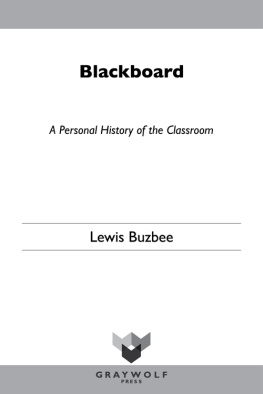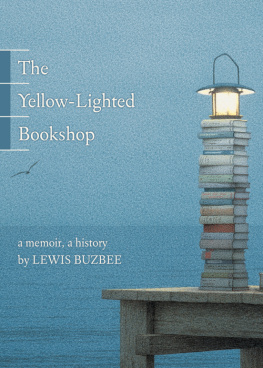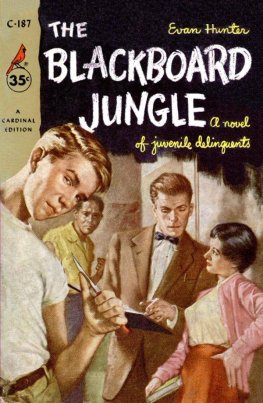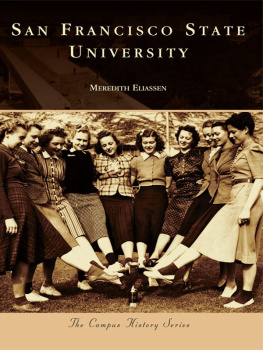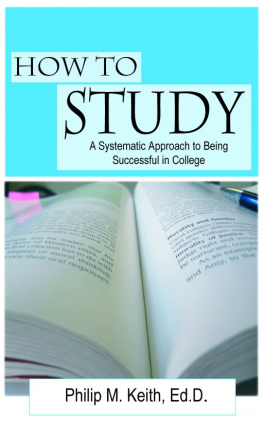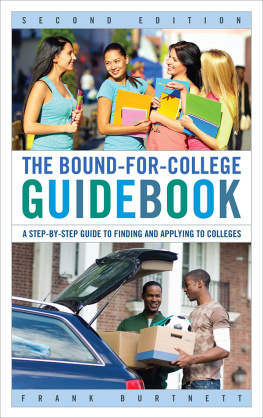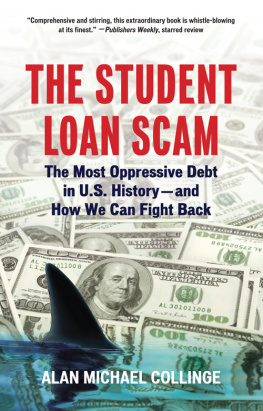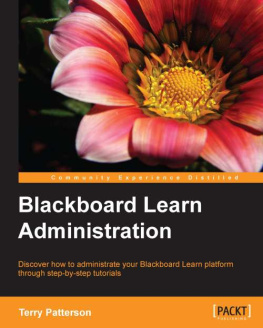Blackboard
A Personal History of the Classroom
Lewis Buzbee
GRAYWOLF PRESS
Copyright 2014 by Lewis Buzbee
This publication is made possible, in part, by the voters of Minnesota through a Minnesota State Arts Board Operating Support grant, thanks to a legislative appropriation from the arts and cultural heritage fund, and through a grant from the Wells Fargo Foundation Minnesota. Significant support has also been provided by Target, the McKnight Foundation, Amazon.com, and other generous contributions from foundations, corporations, and individuals. To these organizations and individuals we offer our heartfelt thanks.

Published by Graywolf Press
250 Third Avenue North, Suite 600
Minneapolis, Minnesota 55401
All rights reserved.
www.graywolfpress.org
Published in the United States of America
ISBN 978-1-55597-683-5
Ebook ISBN 978-1-55597-094-9
2 4 6 8 9 7 5 3 1
First Graywolf Printing, 2014
Library of Congress Control Number: 2013958015
Cover design: Kyle G. Hunter
Cover photos: Vintage school desk ideabug, istockphoto.com; blank blackboard Timur Arbaev, veer.com
for every single one of
my teachers
I never wanted school to be over. Id spend as much time inside school as I could, poring over books we were given, being around the teachers, breathing in the school odors, which were the same everywhere and like no other. Knowing things became important to me, no matter what they were.
Richard Ford, Canada
A teacher of the best sort, whose passion had always beenand remainedto inspire the young into useful lives free from the tyrannies of ignorance, and ready always to follow any fact whithersoever it might lead.
Doris Lessing, Shikasta
Bake Sale
Ive had many opportunities to stop by Bagby Elementary, but, preferring instead drive-by washes of memory, its been decades since Ive set foot here. Today, however, after lunch at her grandmothers, my daughter, Maddy, calls out from the backseat that she wants to take a closer look at my old school. Why not? she says.
Its a deep Indian summer Saturday, warm under a thin plane of rooster tail clouds sliding in from the west. The light of the shortening afternoon is golden and purple at once, and scarlet liquidambar leaves blanket the neighborhoods orderly grid of lawns and sidewalks. This is ideal back-to-school weather, at least to me. Here in the Santa Clara Valley, fifty miles south of San Francisco, the first rains have not yet returned after the bone-dry summer, and the scented aira sharp, nearly acrid decaytells me that school is back in session.
As a child I was at best an average student, never an overachiever, and most Septembers the loss of summers broad freedoms seemed an incomprehensible punishment, but even so, the lure of schools return never failed to send a thrill through me. Whether I was drawn by the crush of the schoolyard and all the other kids who would be there, or unknowingly craved the structure of classes and relief from seemingly infinite summer, or simply recognized the fitness of the worlds turning through time and space, no matter how loud I grumbled, the return to school was momentous.
The first day of school was a simple but ritual occasion in my childhood home. After a special breakfast of Eggs la Goldenrod, my mother and father would stand at the front doorthrilled that summer was over for them too, Im sure, but also because they respected and promoted the value of school for their childrenand I would march off into the rich Indian Summer morning. I smell that promise again today; my skin crackles with a deep and familiar charge.
Maddy, her mom, and I park at the intersection of two broad streets and slip through a break in the cyclone fencing, where we make our way across the vast, grassy playing fields. Bagbys single-story buildings, two wings in an L shape, seem distant, a mirage. This is a typical 1950s public school, one of thousands built during Californias Cold War prosperity. It is not in any way an imposing structure but seems, in fact, rather casual.
Today, young parents guide their toddler up and down a jungle gym in one of the play areas; a father and son take pitching practice at one of the backstops, the ball snapping the air when it smacks into a glove; under a drooping pine a teenage couple, deep in mid-snog, imagines themselves inviolable. And under the classrooms wide eaves, dozens of parents and students shuttle about, adding final touches to makeshift booths that are swathed in black and orange. By chance weve shown up on the day of Bagbys Fall Carnival, a necessary fund-raising event. Ill learn that parents arent allowed to call this a Halloween carnival, for obscurely nuanced and somewhat religious reasons, but will also learn, more dispiritingly, that this is only one of several fund-raisers Bagby parents will hold this year.
Maddy and Julie have raced ahead and taken over a second play yard. Maddy instantly sheds her thirteen-year-old cool and is suddenly much younger, sliding down slides, balancing along a low rail, dangling from monkey bars, swinging on swings, unable to resist. Julie, too, has regressed, it seems, into a more cautious parent; while shes clearly enjoying Maddys exuberance, she stands close by, vigilant, ready to offer comfort or first aid.
Me, Im stuck in the middle of the playing fields, attendant to the swath of the past thats revealed itself. Along with the simple and nostalgic memories Bagby holds for me I did this here, that there I find that many other and larger concerns gather around the school.
I attended school during Californias golden age of education. Funded in large part by the prosperity of the states military-industrial Cold War economy, our public schools were newly built, and fully staffed and funded, a great source of pride to the Unions most populous state. Between 1962 and 1975, when I was a public school student in grades K12, California schools were invariably ranked number one in the nation by all measures. Today, the states public schools are regularly ranked forty-eighth or forty-ninth.
Ive long been dismayed by the prevailing conditions: overcrowded classrooms; drastic cuts to all but the most basic curricula; the deteriorating conditions of buildings and grounds; an emphasis on standardized test scores; the long exodus of excellent teachers, and the imminent threat to teachers seniority and their unions; bloated and costly administrations; fractious public debates about educational content and pedagogical methods. The portrait is a most depressing one.

